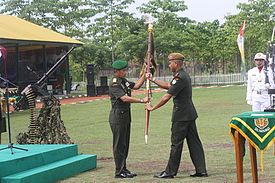

A change of command is a military tradition that represents a formal transfer of authority and responsibility for a unit from one commanding or flag officer to another. The passing of colors, standards, or ensigns from an outgoing commander to an incoming one ensures that the unit and its soldiers is never without official leadership, a continuation of trust, and also signifies an allegiance of soldiers to their unit's commander.
Great symbolism is attached to the ceremonial aspects of a change of command. [1] An inspection and review of soldiers, gun salutes, as well as a military band will often be incorporated into the ceremony. [2]
For a Command Sergeant Major, the transferred item might be a saber during a Change of Responsibility, while for a Chaplain, the item might be the passing of a Clerical Stole. [3]
See also
Footnotes
- ^ The Passage of the Commandants - Gen. Amos takes command of the Marine Corps minute 2:41 and following/13:16. This is also the citation for the coupled sets of orders below, the first for the outgoing commander minute 2:46/13:16, the second for the incoming commander minute 3:13/1316
- ^ "Sequence of Events for Change of Command Ceremony" (PDF). United States Army.[ dead link]
- ^ I Corps Change of Stole Ceremony
External links
-
 Media related to
Change of command ceremonies at Wikimedia Commons
Media related to
Change of command ceremonies at Wikimedia Commons - 34th Combat Communications Squadron (USAF) Change of Command Ceremony Video
- Canadian Army Change of Command – 2016